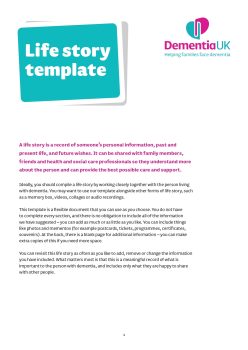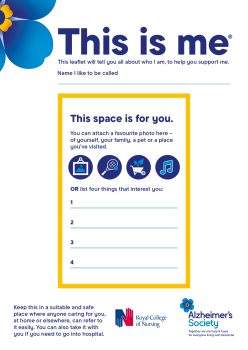Playback speed:
Discover the powerful impact of life story work in dementia care. This article explores how gathering and reflecting on personal narratives enriches identity, deepens empathy, and fosters meaningful connections for persons living with dementia and caregivers alike.
What is a Life Story?
Everyone has their own, unique life story. Our life experiences, beliefs, likes and dislikes, shape us as individuals. Life story work is an activity in which a person living with dementia is facilitated by family members and/or healthcare professionals to gather and review their past. The process of engaging in life story work helps the person to share their stories and enhance their sense of identity1.
Persons Living with Dementia and their Life Story
As dementia progresses, persons living with dementia can experience problems with communication and memory loss. Incorporating personal narratives and biographical knowledge while caring for a person living with dementia has been shown to increase caregiver’s empathy and uphold person-centred care2.
What is the Purpose of a Life Story Resource?
- Provide a guide for family members and/or care staffs to discover the person;
- Celebrate life achievements, special events, holidays, and other occasions that have been historically important to the person;
- Promote and support mental stimulation;
- Provide emotional comfort and pleasure;
- Help engage the person in meaningful conversations about the past where memories are more vibrant and clearer;
- Encourage social interactions between the person living with dementia, family members, and caregivers;
- Provide meaningful interaction to calm the person living with dementia if overwhelmed by other people, events, and noises in the environment;
- Use as a refocusing tool to support the person living with dementia in new and unfamiliar surroundings (e.g. hospital, moving to nursing home, changing rooms, etc.)3.
Making a Life Story Resource
Gather information about the person living with dementia from family members, care staff, case files, or directly from the person living with dementia themselves.
Prepare materials to create a life story, including old photographs, keepsakes, thick files, colored papers, decorative items, colored pencils, paint, glue, scissors, and clear plastic folders.
Suggested topics to include in a life story:
- About me – personal bio
- Favourite food
- Occupation
- Home
- Childhood
- Favourite Idols
- Travel
- Retirement
- Relationships – Significant relationship with family and friends
- Legacy
If the person living with dementia has experienced sad or traumatic events that would cause great distress, you may want to avoid revisiting these life events. However, it may be helpful to explain these on a separate document that can be given to family members or other caregivers so that they can identify whether changes in behaviours are related to a specific events that have happened in the past.
What Does a Life Story Look Like?
When developing a life story with a person living with dementia, one of the following formats, or a combination of formats, can be considered:
- Book
- Collage
- Video recording
- Memory box
- Personal profile document
- Mobile phone application
The life story can be designed in any way that is meaningful to the person living with dementia. Those who prefer to do this virtually can do so using CARA, a lifestyle and community digital platform that provides easy access for persons living with dementia and caregivers to connect to an ecosystem of solutions via a mobile application. CARA has introduced a Care Circle feature, which allows family caregivers to collaborate on shared notes and create Memories, honouring and celebrating the life of their loved one with dementia. These Memory records can be used as personalised content, making every interaction throughout the dementia journey a meaningful one. Find out more about Care Circle here.
However, if you are looking for a more structured template, you can refer to the following resources:
Life Story Template
Source: Dementia UK
Dementia UK’s Life Story template is a practical tool for capturing personal histories, particularly for those with dementia. It offers customisable sections and a straightforward approach for easy documentation. Get started on your story today.
This is Me Template
Source: Alzheimer Society
This is me serves as a tool for life story work, helping caregivers record important details about the background, preferences, and significant life events of the person living with dementia. By using This is me, health and social care professionals can provide more personalised and attentive care based on a deeper understanding of the person living with dementia.
How Do You Engage Persons Living with Dementia in Creating a Life Story Resource?
Involving the person living with dementia as much as possible makes the life story more likely to reflect the person’s wishes and preferences and encourages a sense of ownership. The person living with dementia may also have very different views about the purpose of their life story resource. Respect their wishes about what goes into the life story and who will see it, now and in the future.
Engage and help them where needed, and write or type the information gathered so that they can see the story forming, with you. Try not to overload them with questions. It may be easier to start the conversations with open-ended questions. For example, you might say, “Can you share more about where you grew up?”.
Learn more about effective communication with persons living with dementia here.
Creating the life story may take days, weeks, or even months. Remember that you can always add more information to it later and check in with other family members and friends to provide key information if needed. Remember to also be sensitive as reflecting on one’s life can be emotional.
Conclusion
A life story resource does not stop here. It is retold and remains unfinished. It is also more likely to be successful if life story work is initiated early in the dementia journey. Do continue to add on to the stories and information as conversations with persons living with dementia continues.
Tell us how we can improve?
- Thompson,R. (2011). Using life story work to enhance care. Nurs Older People. 23(8): 16-21. doi: 10.7748/nop2011.10.23.8/16.c8713.
- Doran, C., Noonan, M., Doody, O. (2019). Life-story work in long-term care facilities for older people: An integrative review. J Clin Nurs. 28(7-8):1070-1084. doi: 10.1111/jocn.14718.
Dementia UK, (n.d). Creating a ‘Life Story’ Caring for someone with dementia (n.d.). Retrieved from: https://www.dementiauk.org/wp-content/uploads/dementia-uk-creating-a-life-story.pdf









